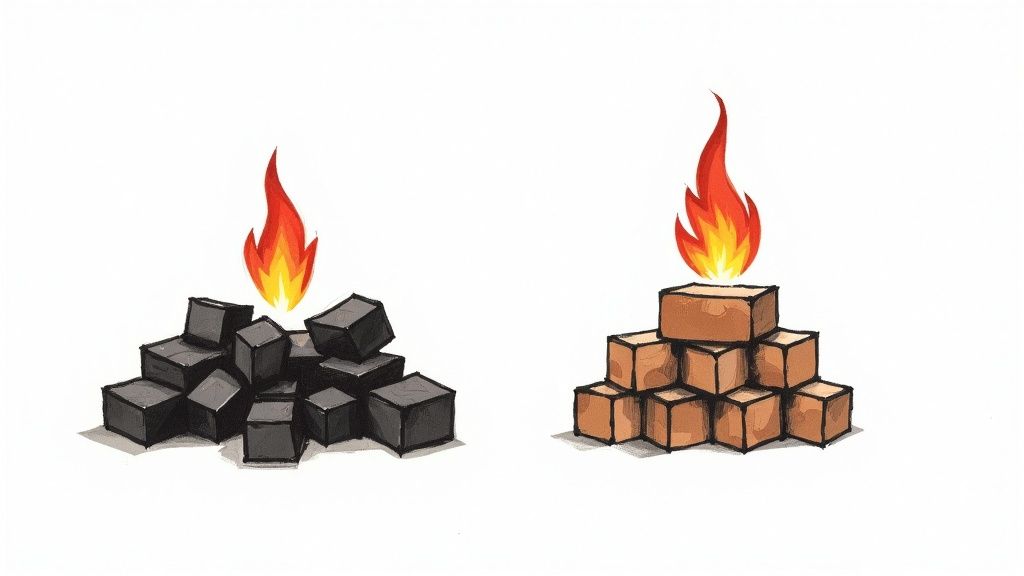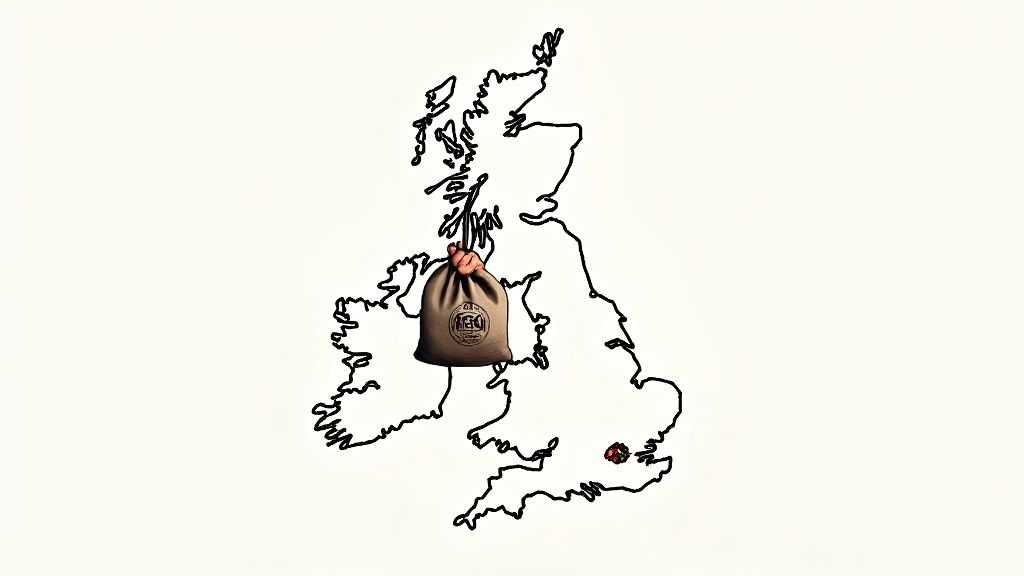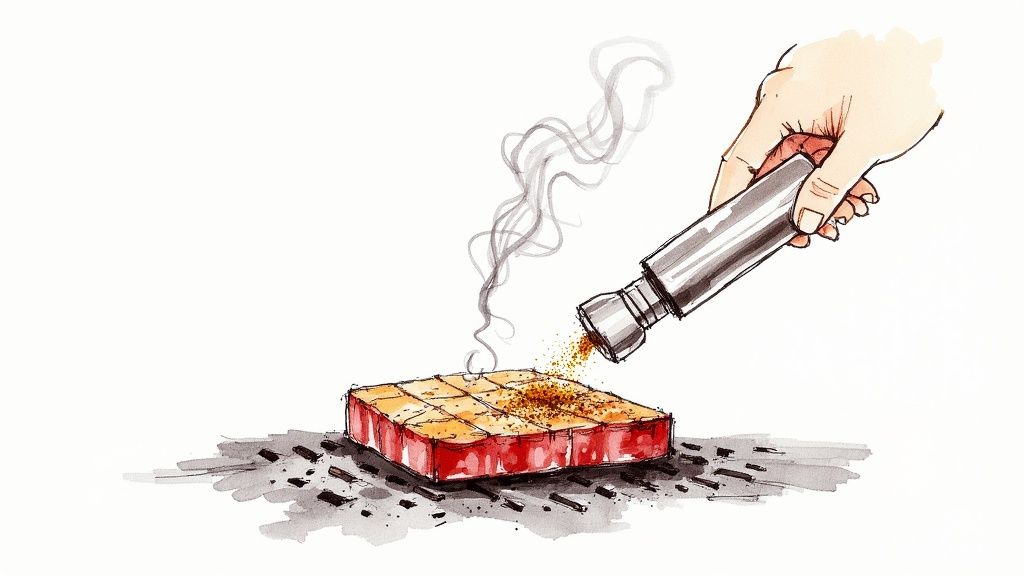Choosing Charcoal for Restaurants Your Complete Guide
Picking the right charcoal for your restaurant isn’t just an operational detail—it's one of the most fundamental culinary decisions you’ll make. It defines your menu’s flavour, your kitchen’s rhythm, and ultimately, your profit margins. The best commercial charcoal gives you that holy trinity of consistent high heat, a clean smoke profile, and long burn times, directly impacting every single dish that lands on a customer's table.
Why Your Charcoal Choice Is Mission-Critical
Think of charcoal as the unsung hero of your grill station. It’s a foundational ingredient with no added crap, but it completely shapes your customer's experience. The fuel you choose influences everything, from the perfect sear on a steak to the subtle smokiness that makes your grilled veg stand out.
In a professional kitchen, getting this right is what separates the memorable from the mediocre. This guide is for chefs and owners who want to move beyond the basics. We'll unpack how the right fuel doesn't just cook food—it elevates your entire menu and builds the kind of customer loyalty that keeps them coming back.
The Foundation of Flavour and Efficiency
In a busy kitchen, consistency is everything. The right charcoal delivers predictable performance, service after service. No guesswork, no surprises.
This means you get:
- Consistent Heat Output: Reliable temperatures mean dishes are cooked perfectly every time. That’s better quality control and less food waste.
- Predictable Burn Times: Charcoal that burns longer and steadier means fewer top-ups during a frantic service. It keeps the workflow smooth and your grill chefs focused.
- A Clean Flavour Canvas: Top-quality charcoal produces minimal acrid smoke, letting the natural flavours of your food and signature seasonings take centre stage.
Choosing your charcoal is like a pitmaster choosing their wood. It sets the tone for everything that follows. It's not just heat; it's the very first layer of flavour you build on. A poor choice here can undermine even the best ingredients.
Balancing Cost, Performance, and Sustainability
Beyond the grill, your charcoal choice has wider implications. Striking the right balance between raw performance, cost-per-service, and sustainability is a massive challenge for any modern restaurant. Today’s diners are more curious than ever about where their food comes from, and that curiosity is starting to extend to how it’s cooked.
We’ll explore this critical balancing act, digging into the growing demand for sustainable, UK-compliant sourcing. This guide gives you a clear roadmap to making an informed, profitable choice—one that ensures your grill is a source of pride, not problems. From understanding the different types of charcoal to mastering performance metrics, you'll get the insight you need to turn your fuel into a real competitive advantage.
Lumpwood vs Briquettes: The Professional Kitchen Showdown

In a professional kitchen, the debate between lumpwood and briquettes isn't just about preference; it's about performance. Forget trying to crown one as "better" than the other. Think of them like a chef's knives—you wouldn't grab a cleaver for delicate slicing, and a paring knife won't get you far when breaking down a whole hog.
Each charcoal type is a specialised tool. Your choice comes down to what you're cooking, the flavour profile you need, and how much hands-on time your kitchen can afford. This is your guide to picking the right fuel for the job, whether it's the raw heat of lumpwood for a perfect steak sear or the steady, reliable burn of briquettes for a twelve-hour brisket.
The Raw Power of Lumpwood Charcoal
Lumpwood is as natural as it gets. It’s simply real wood that’s been charred in a low-oxygen kiln, leaving pure carbon behind. This gives it a few key traits that are gold in a commercial kitchen.
Its biggest draw is how fast it lights and the scorching temperatures it can hit. That raw power is precisely what you need for a lightning-fast, impressive crust on steaks and burgers. The clean smoke also adds a subtle, authentic wood-fired flavour that’s hard to beat.
But that all-natural approach has a flip side. The irregular shapes, while great for airflow, can lead to uneven heat across the grill. Lumpwood also tends to burn down faster than its manufactured cousin, meaning it needs more attention during a busy service.
The Reliable Workhorse: Briquettes
Then you have briquettes—the dependable, consistent workhorse of the charcoal world. These are made by compressing charcoal dust and wood by-products with a binder, creating that classic pillow shape.
That uniform shape is their superpower. It guarantees a predictable, even heat source that spreads consistently across the entire grill, burning long and steady. This makes briquettes the undisputed champion for low-and-slow cooks like pulled pork, ribs, and brisket. Your pitmaster can set the vents and walk away, trusting the temperature will hold for hours.
The trade-off? The smoke profile can be less distinct than single-species lumpwood. It's also critical to source high-quality briquettes made with natural binders (like starch) to avoid any nasty chemical aftertaste. When you’re choosing charcoal for restaurants, the quality of your fuel directly impacts the flavour of your food.
Lumpwood vs Briquettes At a Glance for Professional Kitchens
To make the right call for your menu, seeing the specs side-by-side is a game-changer. The market data tells a similar story of specialisation. In 2024, the UK's charcoal market was valued at around $22.54 million USD, with lumpwood holding the biggest slice at $8.74 million USD.
However, briquettes are the fastest-growing segment, projected to expand at a CAGR of 2.24% by 2032. This points to a rising demand for reliable, long-burning fuel in professional and home settings.
This table breaks down the key performance differences to help you choose wisely.
| Characteristic | Lumpwood Charcoal | Briquettes |
|---|---|---|
| Heat Output | Very high, intense heat | Moderate, consistent heat |
| Burn Time | Shorter, burns faster | Longer, steady burn |
| Lighting Speed | Lights very quickly | Slower to light |
| Heat Consistency | Can have hot and cool spots | Very even and predictable |
| Smoke Flavour | Natural, clean, wood-specific | Milder, more neutral |
| Ash Production | Low ash | Higher ash production |
| Best For | Searing, fast grilling, steaks | Low-and-slow, smoking, large cuts |
Ultimately, most pro kitchens quickly realise the secret isn't choosing one or the other—it's using both. Just as wood pellets bring their own unique flavour to the party, having lumpwood and briquettes on hand gives you the versatility to nail every single dish on your menu.
If you're exploring other fuel types, our wood pellets can add another incredible layer of authentic flavour to your cooking.
The Performance Metrics That Truly Matter

In a busy kitchen, charcoal isn't just fuel. It's a performance ingredient that has a direct say in your bottom line. Forget the simple lumpwood vs. briquette debate for a moment; the real test of professional-grade charcoal for restaurants comes down to how it performs under pressure. Getting these details right is what separates a frustrating, chaotic service from a smooth, efficient one where every single dish comes out perfectly.
These metrics aren't just for BBQ nerds; they're critical operational data. They dictate your fuel costs, kitchen workflow, cleaning rotas, and—most importantly—the final flavour of the food you serve. Let's break down the four pillars of performance that genuinely matter when you're choosing your fuel.
Burn Time and Heat Duration
Time is money in a restaurant, and having to refuel a grill mid-service is pure downtime. Burn time is simply how long a batch of charcoal will burn before it gives up and turns to ash. A longer burn time means your grill holds its temperature through the dinner rush without needing constant top-ups.
This is absolutely crucial for any low-and-slow cooking. A long, steady burn lets pitmasters lock in consistent temperatures for hours on end, which is the only way to properly tenderise those tough, rewarding cuts of meat. Denser, premium charcoal will always deliver superior longevity, directly cutting your cost-per-service.
Heat Consistency and Control
While a roaring hot fire looks impressive, heat consistency is what actually guarantees repeatable results, night after night. It’s all about the charcoal’s ability to maintain a stable temperature across the entire grill, without surprise hot spots or frustrating cool zones.
Heat consistency is the secret to a stress-free grill station. It means your chefs aren't constantly shuffling food around to find the 'sweet spot.' Every inch of the grill becomes prime, usable cooking space, boosting efficiency and ensuring every steak is cooked to the same perfect medium-rare.
Briquettes are often praised for their uniform heat, but high-quality, evenly-sized lumpwood can also deliver the goods. The key is finding a predictable fuel that behaves the same way every time you light it. A chimney starter is your best tool for achieving a fast, even light every single time.
Ash Production
It's easily overlooked, but ash production is a massive performance indicator. The amount of ash left behind directly impacts airflow, and in turn, your grill's entire efficiency.
- Low-Ash Charcoal: This is the hallmark of a pure, high-quality product. Less ash means airflow from the bottom vents stays clear, allowing the fire to breathe and hold a steady temperature.
- High-Ash Charcoal: Cheaper charcoal, often bulked out with fillers, produces a mountain of ash that can quickly clog vents and smother the fire. It literally chokes the coals, causing temperatures to plummet and forcing disruptive, mid-service cleanouts.
Minimal ash doesn't just mean better performance during service; it also drastically cuts down on cleanup time at the end of the night—a huge win for any kitchen crew.
The All-Important Smoke Profile
Finally, and perhaps most importantly, we have the smoke profile. This is where charcoal stops being just a heat source and becomes a core flavour ingredient. The type of wood used to create lumpwood charcoal imparts its own unique signature onto everything you cook with it.
For instance, oak gives a strong but balanced smoke that’s a perfect match for beef, whereas fruitwoods like cherry or apple offer a much milder, sweeter smoke that’s ideal for poultry and fish. The goal is to choose a smoke profile that complements your menu, not one that bullies it into submission. A clean, subtle smoke enhances the natural taste of your ingredients, allowing your signature rubs and seasonings to shine through and create a truly memorable experience for your customers.
How to Source High-Quality and Sustainable Charcoal

Finding a solid charcoal supplier is just as important as finding your butcher or veg man. Seriously. A good partner doesn't just drop off bags of fuel; they deliver consistency, quality, and the peace of mind that comes from knowing your grill will perform night after night.
A reliable supply of top-tier charcoal for restaurants keeps your kitchen humming and ensures every dish has that signature smokey flavour your customers crave. But sourcing goes beyond simple logistics. It's a statement about your brand's values, especially when people are more clued-up than ever about where their food comes from.
This guide will walk you through finding a supplier who delivers the goods – high-performance, responsibly sourced charcoal that won’t let you down during a busy service.
Look for Sustainability Certifications
In today’s world, sustainability isn't just a buzzword; it's a must-have. When you’re checking out potential suppliers, the first thing to look for is a proper, third-party certification.
The gold standard is the Forest Stewardship Council (FSC). If you see that FSC logo on a bag, it's a guarantee that the wood came from responsibly managed forests that support biodiversity and local communities.
Choosing FSC-certified charcoal isn't just about doing the right thing for the planet. It’s a powerful story to tell your customers. It shows you care about every single detail, right down to the embers in the grill, and that kind of commitment builds serious trust.
Prioritise Consistency and Purity
For any professional kitchen, consistency is everything. You can't have your flavour profiles changing from one day to the next. The best way to lock in that predictable burn and taste is by using single-species lumpwood charcoal. Sticking to one type of wood, like oak or birch, means you get the exact same smoke profile, every single time.
This kind of consistency lets you create perfect pairings. Think about it: the deep, beefy smoke from pure oak hitting a steak seasoned with our Revolution Beef Rub. That’s a flavour combination people come back for.
Purity is just as crucial. You need to confirm with any potential supplier that their charcoal is 100% natural, untreated hardwood. Never, ever use charcoal made from chemically treated wood like old furniture or building scraps. It can release toxic fumes when it burns, creating a massive food safety risk for your team and your customers. It’s a non-starter.
Vet Your Suppliers Thoroughly
Once you’ve got a shortlist, it's time to dig a little deeper and ask the right questions. Any decent supplier will be totally transparent about their operation and keen to show off the quality of their product.
Here’s what you need to ask:
- What's your production method? Ask if they use traditional kilns. This old-school method often results in denser, higher-quality charcoal that burns longer and hotter.
- Where do you source your wood? Find out exactly where it comes from to make sure it lines up with your sustainability goals. Sourcing British-made charcoal is a great way to slash your carbon footprint and support the local economy.
- Can I get a sample? This is the ultimate test. Ask for a bag to put through its paces in your own kitchen. Test the burn time, heat consistency, and how much ash it produces during a mock service.
Choosing a charcoal supplier is a long-term relationship. Take the time to vet them properly, and you’ll end up with a product that meets your culinary standards and reflects your restaurant’s commitment to doing things right.
Understanding UK Regulations and Emissions Standards
Running a commercial charcoal grill in the UK isn't just about getting the perfect char; it's about playing by a very specific set of environmental and safety rules. Getting this right is non-negotiable for keeping your restaurant compliant, safe, and attractive to today’s clued-up, eco-conscious diners.
Think of these regulations less as red tape and more as future-proofing your business. It’s a sign of professionalism that shows you’re serious about doing things the right way. Let's cut through the jargon and get straight to what you need to know.
Navigating DEFRA and Smoke Control Areas
The main player you need to know about is the Department for Environment, Food and Rural Affairs (DEFRA). Across the UK, many towns and cities are designated Smoke Control Areas, which puts a tight leash on how much smoke you can legally let out of your chimney.
If your restaurant falls within one of these zones, you can't just burn any old fuel. The law says you must use an "authorised fuel" or an "exempt appliance" that’s been officially tested and approved by DEFRA for its low smoke output. This has a massive impact on your choice of charcoal for restaurants, pushing you towards cleaner, high-grade options that meet the standard.
These strict emission rules have actually spurred on a lot of innovation in grill tech and shifted the whole industry towards better, cleaner fuels.
The Critical Role of Ventilation and Extraction
Beyond what you’re burning, your kitchen setup is just as important. When you're working with live fire, understanding commercial kitchen ventilation requirements isn't just a box-ticking exercise—it's absolutely critical for safety and compliance. A proper extraction system is not a 'nice to have'; it's a must.
It does two crucial jobs:
- Safety: It pulls dangerous combustion gases like carbon monoxide out of the kitchen, protecting your team from serious health risks.
- Compliance: A good system traps smoke and particulates before they escape, helping you meet local air quality rules and—importantly—avoiding complaints from your neighbours.
A professional-grade extraction system, complete with the right filters, is one of the most important investments you'll make for a charcoal-fired kitchen. It creates a safe place to work and keeps you on the right side of the law.
Choosing Compliant Charcoal
So, how do you make sure the charcoal you're buying is actually compliant? The smartest move is to find a reputable supplier who really knows the legal landscape inside and out.
Don't be shy—ask them straight up if their products are suitable for Smoke Control Areas. Generally, you’ll find that high-quality, dense briquettes made with natural binders and pure lumpwood charcoal produce far less smoke. They're often the go-to for commercial kitchens that have to meet these tight regulations. Making the right choice here doesn't just protect your business; it cements your reputation as a professional spot that takes quality and safety seriously.
Pairing Charcoal Flavour with the Right Seasoning

Choosing the right charcoal for restaurants gives you the smoky canvas; the seasoning is how you create the masterpiece. Think of your fuel as the foundation of your flavour symphony. The rubs and spices you layer on top are what turn a simple grilled dish into a signature item that people talk about.
This is where the real art comes in. You want your seasoning to complement the charcoal's smoke profile, not fight it or, even worse, completely mask it. A delicate applewood smoke, for example, can easily be steamrolled by an aggressive rub. On the other hand, a bold mesquite needs a seasoning that can stand its ground.
How to Season Chicken Thighs for the Grill in 2 Minutes
Here's a quick, practical example of how to build authentic flavour fast. For a batch of chicken thighs destined for the charcoal grill:
- Pat the chicken dry. This is crucial for a crispy skin.
- Use a binder. A very light coating of olive oil or hot sauce helps the rub stick.
- Season generously. For a smoky, zesty flavour with a gentle kick, grab the Chipotle Cowboy Chicken Rub. Sprinkle it evenly over all sides of the chicken, pressing it in gently.
- Let it rest. Even 15 minutes at room temperature allows the salt to start working its magic, making the chicken juicier.
- Grill. Cook over a medium-hot charcoal fire until cooked through. The result is perfectly seasoned, smoky chicken every time.
Think of your charcoal and seasoning as a duet. One can be the lead vocal and the other the harmony, but they have to work together. When the pairing is right, the result is a flavour far greater than the sum of its parts.
Matching Intensity for Perfect Balance
Let the intensity of your charcoal's smoke guide your seasoning choices. A powerful smoke from mesquite lumpwood, for example, pairs beautifully with the earthy and spicy notes you'd find in our Holy Jalapeño Fajita Seasoning. The smoke is big enough to handle those big flavours without getting lost.
On the flip side, the gentle smoke from fruitwoods provides the perfect backdrop for rubs with more nuanced, herbaceous profiles like the authentic flavours in our Greek Odyssey Gyros Rub.
Ultimately, the goal is to create a balanced, memorable flavour profile that keeps your customers coming back for more. By thoughtfully matching your high-quality charcoal with equally well-crafted seasonings, you turn every dish from the grill into an intentional culinary statement.
FAQs: Your Commercial Charcoal Questions Answered
What is the best charcoal for low and slow cooking?
For low-and-slow applications like brisket or pulled pork, premium hardwood briquettes are the champion. Their uniform shape and density provide a stable, consistent heat for hours, meaning less fire management and more predictable results. Always opt for briquettes made with natural binders to ensure a clean burn that won't taint your food with chemical flavours.
How much charcoal does a restaurant typically use?
This varies hugely depending on your menu, grill size, and hours of operation. A steakhouse using high heat for searing will consume charcoal much faster than a BBQ joint maintaining low temperatures. As a general estimate, a medium-sized commercial grill might use 10-20kg of charcoal per service. The best approach is to conduct trial runs to accurately measure your usage and forecast fuel costs.
Should I use different types of charcoal for different dishes?
Absolutely. This is key to culinary control. Using different charcoals gives you the versatility to perfect the flavour of every dish.
- For Searing Steaks: High-heat lumpwood (like oak) is ideal for creating a perfect crust.
- For Fish and Chicken: A milder lumpwood (like cherry) adds a subtle kiss of smoke without overpowering delicate proteins. Our Wingman Wing Rub pairs beautifully with this gentle smoke.
- For Long Cooks: Briquettes provide the steady, reliable heat needed for large cuts of meat that require hours on the grill.
How does ash production affect grill performance?
High ash production is a performance killer. Excessive ash can clog bottom vents, restricting airflow and smothering the coals. This leads to temperature drops and inefficient fuel consumption. Choosing a low-ash charcoal is crucial for maintaining consistent heat, reducing mid-service maintenance, and speeding up end-of-night cleanup.
At Smokey Rebel, we believe the right seasoning is the ultimate partner for carefully chosen charcoal. To build those unforgettable flavour profiles, have a look at our range of small-batch BBQ rubs and find the perfect match for your menu.
Check out our full collection, including the best-selling Best Sellers Gift Set.
Join our Mailing List
Sign up and get Smokey Rebel Recipes + weekly recipes straight to your inbox!
Recent articles
A Meal Prep Guide To Save Time, Money, And Flavour
Master the art of meal prep with our guide. Discover practical tips, weekly menus, and flavour secrets to make your...
Read moreUnforgettable Ideas for Presents for Him
Struggling with ideas for presents for him? Explore our expert guide to unique, thoughtful gifts he'll actually use, from BBQ...
Read moreThe Ultimate Guide to Finding the Perfect Gift for BBQ Lovers
Struggling to find the perfect gift for BBQ lovers? Our complete guide covers unique ideas for every griller, budget, and...
Read more


